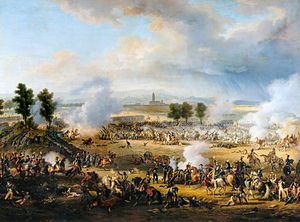War of the Second Coalition
| War of the Second Coalition | |||||||
|---|---|---|---|---|---|---|---|
| Part of the French Revolutionary Wars | |||||||
 Louis-François Lejeune: The Battle of Marengo | |||||||
| |||||||
| Belligerents | |||||||
|
|
| ||||||
| |||||||
The "Second Coalition" (1799–1802) was the second attempt by other European powers to contain or eliminate Revolutionary France. After Napoleon Bonaparte mounted an expedition to Egypt and, in spite of several land victories, was unable to transport his army back by sea after the Battle of the Nile, a number of France's enemies prepared a new alliance with Britain to undo his previous conquests. Austria and Russia raised fresh armies for campaigns in Germany and Italy in 1799.
The only military activity before the end of 1798 was in Italy, where Naples captured Rome on 28 October but was driven out by the end of the year.
In Italy, Russian general Aleksandr Suvorov won a string of victories driving the French under Moreau out of the Po Valley, and forcing them back on the French Alps and the coast around Genoa. However, the Russian armies in the Helvetic Republic (Switzerland) were defeated by Andre Massena, and Suvorov's army was eventually withdrawn for political reasons.
In Germany, Archduke Charles of Austria drove the French under Jean-Baptiste Jourdan back across the Rhine, and won several victories in Switzerland. Jourdan was replaced by Massena.
Russia left the coalition on account of British insistence that they would have right to search any vessel on the sea.
By the end of the year, Napoleon had returned from Egypt, leaving his army behind, and took control of France in a coup d'etat. He reorganized the French armies and command for the next year's campaign.
In 1800, Napoleon took personal command of the army in Italy, and eventually won a victory at the Battle of Marengo against the Austrian general Michael Melas, driving the Austrians back toward the Alps.
In Germany, General Moreau defeated Archduke Johann at the Battle of Hohenlinden, forcing him to sign an armistice.
In February 1801 the Austrians signed the Treaty of Lunéville, accepting French control up to the Rhine and the French client republics in Italy and the Netherlands.
The Treaty of Amiens between France and Britain began the longest break in the war between the two during the French Revolutionary and Napoleonic periods.
